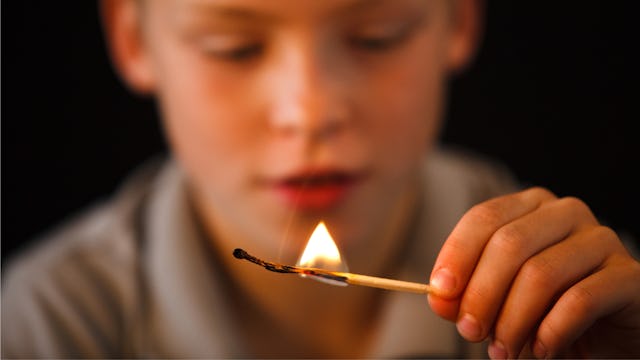Kids Playing With Matches Might Be A Good Thing

When I was about 7 or 8 years old, I used to sit at my mother’s desk in her bedroom and turn on the small lamp that sat on it. It was a typical desk lamp, with a small and powerful light bulb with a metal hood over the top. When the lamp was on, the bulb and the metal would get extremely hot. I would sit there and tear up pieces of paper, holding a ripped corner up and touching it to the metal shade or the bulb until it started to smoke. I liked the burned edges this created.
One day, a small ember glowed on the burnt side of my torn paper. Having never dealt with an actual flame in my life and assuming it was about to burst into a roaring flame, I threw it and ran, screaming that there was a fire and scaring the living shit out of my family. The tiny ember extinguished itself pretty quickly, and I was read the riot act on fire safety.
I never played with that lamp again.
But was fear the best defense for my family against an accidental arsonist child? Probably not. I’m still iffy around flames as an adult. And if the ember on that paper would have been more serious, it would have been to everyone’s benefit that I knew how to handle it. Not throwing it next to a bunch of other papers, for starters.
So when I read in the New York Times about an effort in Berlin to teach children about fire safety by letting them play with fire, I was on board pretty quickly.
Kain Karawahn, an artist, teaches workshops to young children in Berlin so they can learn how to responsibly handle and react to fire in their everyday lives — under close adult supervision, of course. The goal of his courses is to let children play with fire while supervised to help prevent the tragedies that can occur when they play with it privately and in secret. He wants kids to not only learn how to safely make a fire, but how to respond to fire. Not all kids are huge screamers like I was. When some set fires in secret, they won’t tell an adult at all, for fear of getting into trouble. Or they may hide, which can endanger their lives, putting them at risk of death from inhaling smoke.
In many parts of the world, like here in the U.S., children don’t learn about building a fire until they are much older, if at all. Until that age, they are taught to avoid it entirely. At a recent field trip to our local firehouse, I remember all of the fire safety emphasizing what to do if you see a fire, but nothing about how to handle it safely on your own. This may be because we don’t want kids messing with fire at all, which would be ideal, but I’m as good an example as any that children are curious and often seek out learning through experience.
So which way is the right way? There isn’t any significant data to support either approach. But I personally like the idea of taking away some of the mystery and draw for kids by letting them learn in a controlled environment with adults. I’m not here to advocate devoting a drawer of your toy storage to Zippos and Sterno cans, so don’t flame me yet, but I think we can all understand the benefit of removing some of the forbidden-fruit aspects of fire and replacing them with knowledge and respect. We remove the taboo, secretive nature which sometimes is the draw to danger for children.
My children are pretty young — 4 and 2 years old. While I like the idea of teaching them about fire, I think they’re both a little too young for me to feel comfortable just yet — and probably too young for them to understand what I’m trying to teach them and why. My oldest already displays a lot of my freak-out tendencies, so I doubt I’ll be handing him a lit match anytime soon unless I want it thrown back at me while he runs away screaming. But I will probably take a moment the next time I light a candle to show him what I’m doing and to reiterate a bit of the basic fire safety he already knows.
We can work our way up to Zippos.